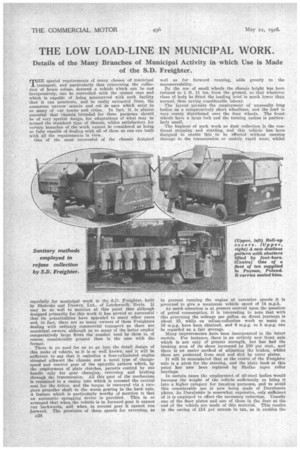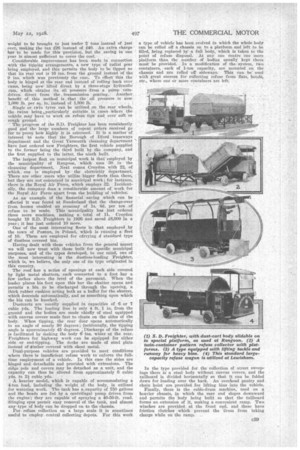THE LOW LOAD-LINE IN MUNICIPAL WORK.
Page 144

Page 145

If you've noticed an error in this article please click here to report it so we can fix it.
Details of the Many Branches of Municipal Activity in which Use is Made of the S.D. Freighter.
THE special requirements of many classes of municipal transport, and particularly that concerning the collection of house refuse, demand a vehicle which can be rurt inexpensively, can be controlled with the utmost ease and which is capable of being rnanceuvred with such facility that it can penetrate, and be easily extracted from, the numerous narrow streets and eul de sacs which exist in so many of our towns and cities. In fact, it is almost essential that 'chassis intended for these purposes should be of very special design, for adaptations of what may be termed the Standard type of chassis, whilst satisfactory for certain branches of the work, cannot be considered as being so fully capable of dealing with all of them as can one built with all the requirements in view. One of the most successful of the chassis designed•
especially for municipal work is the S.D. Freighter, built by Shelvoke and Drewry, Ltd., of Letchworth, Herts. It may be as well to mention at this point that although designed primarily for this work it has proved so successful that its potentialities have appealed to many other users and, in fact, there are as many owners of these Freighters dealing with ordinary commercial transport as there are municipal owners, although as so many of the latter employ comparatively large fleets the number used hy them is, of course, considerably greater than is the case with the former.
There is no need for us to go into the detail design of this make of vehicle, as it is so well known, and it will be sufacient to say that it embodies a four-cylindered engine situated athwart the chassis and a novel type of changespeed and control gear of the epicyelic pattern which, by the employment of plate clutches, permits control by one handle only for gear changing, reversing and braking through the transmission. All this part of the mechanism is contained in a casing into which is recessed the central seat for the driver, and the torque is conveyed via a twopiece propeller shaft to the worm gearing in the back axle. A feature which is particularly worthy of mention is that an automatic spragging device is provided. This is so arranged that when the vehicle is in forward gear it cannot run backwards, and when in reverse' gear it cannot run forward. The provision of three speeds for reversing, as C38 well as for forward running, adds greatly to the manceuvrability.
By the use of small wheels the chassis height has been reduced to 1 ft. 11 ins, from the ground, so that whatever class of body be fitted the loading level is much lower than normal, thus saving considerable labour.
The layout permits the employment of unusually long bodies on a comparatively short wheelbase, and the load is very evenly distributed over the four wheels. The front. wheels have a large lock and the turning radius is particularly small.
The bugbear of such work as dust collection is the continual stopping and starting, and this vehicle has been designed to enable this to be effected without causing damage to the transmission or unduly rapid wear, whilst to prevent running the engine at excessive speeds it is governed to give a maximum vehicle speed of 14 m.p.h.
As much attention is at present centred upon the question of petrol consumption, it is interesting to note that with this governing the mileage per gallon on direct journeys is about 15, while on refuse-collection work as many as 10 m.p.g. have been obtained, and 6 m.p.g. to S m.p.g. can be regarded as a fair average.
Many improvements have been ineorposated in the latest models. For instance, there is an entirely new front axle which is not only of greater strength, but has had the braking area of its shoes increased by 100 per cent., and there is an easier method of adjusting the brakes, whilst these are protected from mud and dirt by cover plates.
It will be remembered that at the centre of the Freighter axle is a pivot for the steering, and the plain bush at this point has now been replaced by Skefko taper roller bearings.
In certain vases the employment of all-steel bodies -would increase the weight of the vehicle sufficiently to bring it into a higher category for taxation purposes, and to avoid this considerable _use is now being made of Duralnmin plates. As Duralnmin is somewhat expensive, only sufficient of it is employed to effect the necessary reduction. Usually one of the floor plates and one of those in the door at the end of the vehicle are made of this material. This results in the saving of £14 per annum in tax, as it enables the
weight to be brought to just under 2 tons instead of just over, making the tax £26 instead of 140. An extra charge has to be made for this"provision, but the saving in one year is almost sufficient to cover the cost.
Considerable improvement has been made in connection With the titming arrangements, a new type of radial gear being employed, and this permits the body to be tipped so that its rear end is 16 ins. from the ground instead of the 9 ins, which was previously the case. To effect this the body is hinged at the rear end instead of rolling back over cams, being now lifted direct by a three-stage hydraulic ram, whicli obtain its oil pressure from a pump
driven direct direct frOm • the , transmission gearing. AnOther benefit of. this method is that the oil pressure is now 1,000 lb. per sq. in. instead of 1,800 lb.'
Single or twin tyres can be utilized on the rear wheels, the twins being sparticularly suitable, in eases Where the vehicle may have to work on refuse tips and over soft or rough ground. • The progress of the S.D. Freighter has been consistently good and the large numbers of repeat orders received go far to prove how highly' it is esteemed. It is a matter of interest to note that the Borough of Ilford tramways department and the Great Yarmouth cleansing department have just ordered new Freighters, the first vehicle supplied to the former being the third built by the company, and the first supplied to the latter, the ninth built.
The largest fleet on municipal work is that employed by the municipality, of Rangoon, which uses 30 in the cleansing department Next comes Croydon with 22, of which one is employed by the electricity department. There are other .users who utilize bigger fleets than these, but they are not concerned in municipal work ; instance, there is the Royal Air Force, which employs 32. Incidentally, the company does a considerable amount of work for the Royal Air Force apart from the building of vehicles.
As an example of the financial -saving which can be effected it was found at Sunderland that the change-over from horses enabled an economy of is. (id, per ton of refuse to be made. This municipality has just ordered three more machines, making a total of 11. Croydon bought 19 S.D. Freighters in 1926 and saved £8,000 in a year ; it has just ordered 10 more.
One of the most interesting fleets is "that employed by the town of Poznan, in Poland, which is running a fleet of 10. These are employed for carrying ti standard type of dustless covered bin.
Having dealt with these vehicles from the general aspect we will now treat with those built for specific municipal purposes, and of the types developed, to our mind, one of the most interesting is the dustless-loading Freighter, which is, we believe, the only one of its type originated in this country.
The roof has a series of openings at each side covered by light metal shutters, each connected to a foot bar a few inches above the level of the pavement. When the loader places his foot upon this bar the shutter opens and permits a bin to be discharged through the opening, a thick rubber cushion acting both as a buffer for the shutter, which descends automatically, and as something upon which the bin can be knocked.
Dustcarts are usually supplied in capacities of 6 or 7 cubic yds. The loading line is only 4 ft. 1 in. from the greund and the bodies are made chiefly of steel equipped with canvas covers made fast to cleats on the sides of the body. When tipping, the rear door opens automatically to an angle of nearly 90 degrees; incidentally, the tipping angle is approximately 45 degrees. , Discharge of the refuse is facilitated by Making the body 6 ins, wider at the rear. Freighters for highway work can be equipped for either side or end-tipping. The decks are made of steel plate instead of timber covered with sheet metal.
Dual-purpose vehicles are provided to meet conditions where there is insufficient refuse work to enforce the fulltime employment of a vehicle. In this case the sides are hinged and detachable and provided with extensions. The ridge pole and covers may be detached as a unit, and the capacity can thus be altered from approximately 6 cubic yds. to 2i cubic yds. •
A heavier model, which is capable of accommodating a 4-ton load, including the weight of the body, is utilized for watering work, The tank has a capacity of 750 gallons and the heads are fed by a centrifugal pump driven from the engine'; they are capable of spraying a 40-50-ft. road. Slinging eyes permit easy removal of the tank, and almost any type of body can be dropped on to the•chassis.
For refuse collection on a large Bede it is sometimes useful to employ central collecting depots. For this work
a type of vehicle has been evolved in which the whole body can be rolled off a chassis on to a platform and left :to bo. tilled, being replaced by a full body, which is taken to the point of refuse disposal. At any one centre 'one snore platform than the number of bodies usually kept there mustbe provided. In a modification of the system, two containers, each of 1-ton capacity, are mounted on the chassis' and are rolled off sideways. This can be used withgreat success for collecting refuse from flats, hotels, etc., where' one or more containers are left.
In the type provided for the collection of street sweepings there is a steel body without canvas covers, and the tailboard is divided horizontally so that it can be folded down for loading over the back. An overhead gantry and chain hoist are provided for lifting bins into the vehicle.
Finally, there is the cable-drum machine, used on a heavier chassis, in which the rear end slopes downward and permits the body being built so that the tailboard forms an extension of it, making a convenient ramp. Two winches are provided at the front end, and these have friction clutches which prevent the *drum from taking charge while on the ramp.




















































































































































































































